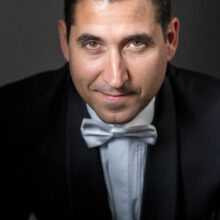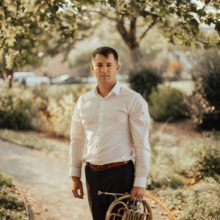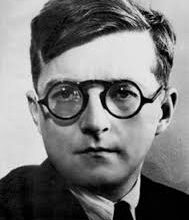About the Music
Single tickets and subscriptions for this performance are available for sale only on our website or by calling the Box Office at 410-263-0907.
$10 student tickets and discounts for active duty and military service members, law enforcement, and front line workers are available. Please call the Box Office at 410-263-0907 to take advantage of these offers.
View the digital Subscription Season Booklet by clicking on this link.
Adolphus Hailstork, Three Spirituals
Composed: 2005
Length: 9 minutes
Premiere: 2005
Instrumentation: 2 flutes (2nd doubling piccolo), 2 oboes (2nd doubling English horn), 2 clarinets, 2 bassoons, 2 horns, 3 trumpets, 3 trombones, 1 tuba, timpani, bass drum, snare drum, cymbal, suspended cymbal, and strings
Tune in to the Music: Three Spirituals for Orchestra by the Sewanee Orchestra conducted by JoAnn Faletta
What to Listen For: In the first movement, Hailstork uses the bassoon, trumpet and horn to play solo lines, which invite the orchestra to unite for the crescendo. The second movement is based on the familiar song, Kum Ba Yah.
 Adolphus Hailstork III (April 17, 1941, Rochester, New York) is an American composer of African American, Native American and European ancestry. His works are known for blending musical ideas from the African, American and European traditions. Hailstork received his music education at Howard University, Manhattan School of Music, and Michigan State University. He currently resides in Virginia Beach, Virginia, and is the Cultural Laureate of Virginia. While his compositions employ contemporary compositional techniques, Hailstork writes in a wide variety of genres, including concert band literature, and often uses material relating to African-American traditions for inspiration. His wide span of musical compositions ranges from symphonies, opera, and a violin concerto, to “Springtime for Two Elephants” for two tubas. Hailstork was the second African-American composer ever to be featured at a Presidential Inauguration when his Fanfare on Amazing Grace was performed as part of the prelude to Joe Biden’s inauguration in January 2021. His latest cantata, A Knee on the Neck, was written in commemoration of George Floyd’s murder and premiered in 2021.
Adolphus Hailstork III (April 17, 1941, Rochester, New York) is an American composer of African American, Native American and European ancestry. His works are known for blending musical ideas from the African, American and European traditions. Hailstork received his music education at Howard University, Manhattan School of Music, and Michigan State University. He currently resides in Virginia Beach, Virginia, and is the Cultural Laureate of Virginia. While his compositions employ contemporary compositional techniques, Hailstork writes in a wide variety of genres, including concert band literature, and often uses material relating to African-American traditions for inspiration. His wide span of musical compositions ranges from symphonies, opera, and a violin concerto, to “Springtime for Two Elephants” for two tubas. Hailstork was the second African-American composer ever to be featured at a Presidential Inauguration when his Fanfare on Amazing Grace was performed as part of the prelude to Joe Biden’s inauguration in January 2021. His latest cantata, A Knee on the Neck, was written in commemoration of George Floyd’s murder and premiered in 2021.
About the Music:
Three Spirituals for Orchestra was composed in 2005 in celebration of the reopening of the Attucks Theater in Norfolk, Virginia. It is structured by three movements, each based on traditional spiritual songs.
Movement I – Everytime I Feel the Spirit
Movement II – Kum Ba Yah
Movement III – Oh Freedom
Óscar Navarro Connection: Horn Concerto, Alex Kovling, Horn
Composed: 2019
Length: 26 minutes
Premiere: April 2019, commissioned by the National Institute of performing Arts and Music (INAEM), for the Spanish National Orchestra and Choir (OCNE)
Dedication: Salvador Navarro
Instrumentation: Solo horn, 2 flutes, 1 piccolo, 2 oboes, 2 clarinets, 2 bassoons, 4 horns, 3 trumpets, 3 trombones, 1 tuba, timpani, xylophone, marimba, glock, claves, suspended cymbal, wood block, snare drum, triangle, tam-tam, crecelle, bass drum, cymbal, temple blocks, harp, piano, and strings
Tune in to the Music: Javier Bonet playing “Connection” with Thailand Philharmonic Orchestra, conducted by José Luis Novo
What to Listen For: Connection is conceived as a concerto in a single movement without pauses. The piece is divided into an introduction followed by four sections: March, Scherzando, Slow, and Grand Finale. Enjoy the solo horn concerto, an unusual treat for the audience, performed by ASO’s Principal Horn Alex Kovling.
 Óscar Navarro (b. 1981, Novelda, Spain) began studying the clarinet at an early age. He received a degree in music from the Conservatorio Superior Oscar Espla in Alicante, Spain, and studied composition and conducting at the Allegro Internacional Music Academy in Valencia. Navarro has numerous national and international composition awards, and his music is performed and premiered in large concert halls around the world. In fact, ASO Maestro José-Luis Novo conducted Connection for the Thailand Philharmonic Orchestra in Bangkok, Thailand in December 2019, following its April 2019 première for the Spanish National Orchestra at the Auditorio Nacional de Música in Madrid.
Óscar Navarro (b. 1981, Novelda, Spain) began studying the clarinet at an early age. He received a degree in music from the Conservatorio Superior Oscar Espla in Alicante, Spain, and studied composition and conducting at the Allegro Internacional Music Academy in Valencia. Navarro has numerous national and international composition awards, and his music is performed and premiered in large concert halls around the world. In fact, ASO Maestro José-Luis Novo conducted Connection for the Thailand Philharmonic Orchestra in Bangkok, Thailand in December 2019, following its April 2019 première for the Spanish National Orchestra at the Auditorio Nacional de Música in Madrid.
About the Music:
Of his composition Connection, Navarro says “The aim of this piece is to captivate the attention and create a direct connection with the listener, making the musical message reach the listener via the solo instrument, the horn. Mystery, anger, complicity, humor or passion are part of the main aesthetic ingredients used in this concerto, whose purpose is to immerse the listener in the work through a fusion of styles and a varied harmonic language.”
 Alex Kovling, Principal Horn of the Annapolis Symphony Orchestra since 2020 and member of the orchestra since 2018, is a native of Lewisville, Texas. He joined the U.S. Navy Band in 2015. Alex also plays chamber music as a member of Barclay Brass and with his brass quintet, Apex Brass. He has enjoyed covering principal and soloing with the Navy Band and has even performed alongside Mannheim Steamroller, Andrea Bocelli, The Beach Boys, and Katy Perry.
Alex Kovling, Principal Horn of the Annapolis Symphony Orchestra since 2020 and member of the orchestra since 2018, is a native of Lewisville, Texas. He joined the U.S. Navy Band in 2015. Alex also plays chamber music as a member of Barclay Brass and with his brass quintet, Apex Brass. He has enjoyed covering principal and soloing with the Navy Band and has even performed alongside Mannheim Steamroller, Andrea Bocelli, The Beach Boys, and Katy Perry.
Mr. Kovling received his Bachelor of Music from Texas Tech University, where he studied with Christopher M. Smith. After graduating, he continued his studies with William VerMeulen at Rice University, earning his Master’s Degree in Music.
Dmitri Shostakovich Symphony No. 10 in E minor, Op. 93
Composed: 1951-1953
Premiered: 17 December 1953 Leningrad Philharmonic Orchestra conducted by Yevgeny Mravinsky
Length: 50 minutes
Instrumentation: 2 flutes (2nd doubling piccolo), 1 piccolo, 3 oboes (3rd doubling English horn), 3 clarinets (3rd doubling E-flat clarinet), 3 bassoons (3rd doubling contrabassoon), 4 horns, 3 trumpets, 3 trombones, 1 tuba, timpani, snare drum, tam-tam, triangle, tambourine, xylophone, cymbal, suspended cymbal, bass drum, and strings
Tune in to the Music: Shostokavich Symphony No. 10, The Mariinsky Orchestra and Chorus conducted by Valery Gergiev
What to Listen For: Russian composer Pyotr Ilyich Tchaikovsky used marches and waltzes for interior movements of his compositions, a technique Shostokovich replicated. Listen for a march in the second movement and a waltz in the third. Artistic Director José-Luis Novo says Shostakovich’s 2nd movement is four minutes of hair-raising symphonic music symbolizing the oppression of Stalin’s brutal regime that will keep you on the edge of your seat.
 Dmitri Dmitriyevich Shostakovich (25 September 1906 – 9 August 1975) was a Soviet-era Russian composer and pianist. Over the course of his career, he earned several important awards, including the Order of Lenin from the Soviet government. At various points, however, he was condemned, renounced, and censured by the Soviet leadership; but praised, defended, and much-respected by his peers. For much of his career, Shostokovich maneuvered between being in or out of favor with Joseph Stalin’s notoriously mercurial regime. Thus, he was often judged within Russia by political rather than musical criteria.
Dmitri Dmitriyevich Shostakovich (25 September 1906 – 9 August 1975) was a Soviet-era Russian composer and pianist. Over the course of his career, he earned several important awards, including the Order of Lenin from the Soviet government. At various points, however, he was condemned, renounced, and censured by the Soviet leadership; but praised, defended, and much-respected by his peers. For much of his career, Shostokovich maneuvered between being in or out of favor with Joseph Stalin’s notoriously mercurial regime. Thus, he was often judged within Russia by political rather than musical criteria.
Shostokovich once described life under Stalin’s regime as “unbelievably mean and hard. Every day brought more bad news and I felt so much pain. I was so lonely and afraid.” Joseph Stalin’s Great Terror began in 1936, when many of Shostakovich’s friends and relatives were imprisoned or executed, including his patron Marshal Tukhachevsky; his brother-in-law, the distinguished physicist Vsevolod Frederiks; his great friend the musicologist Nikolai Zhilyayev; his mother-in-law, the astronomer Sofiya Mikhaylovna Varzar; his uncle Maxim Kostrykin; and his colleagues Boris Kornilov and Adrian Piotrovsky. In 1937, Shostokovich was summoned for interrogation and only escaped due to a twist of fate: his interrogator was arrested before his own appointment came. In 1948 Shostokovich’s work was denounced under the Zhdanov Doctrine, with severely punitive professional and financial consequences lasting several years. Even after his censure was rescinded in 1956, performances of his music were occasionally subject to state interventions. Later, as he tiptoed around Communist politics, Shostakovich was a member of the Supreme Soviet of the RSFSR (1947) and the Supreme Soviet of the Soviet Union (from 1962 until his death), as well as chairman of the RSFSR Union of Composers (1960–1968). “Without party guidance,” he said, “I would have displayed more brilliance, used more sarcasm, I could have revealed my ideas openly instead of having to resort to camouflage.”
About the Music
Since the end of the 1970s, the most widely accepted interpretation of this work views it as a depiction of the Stalin years in Russia, when between eight and 20 million people died as a direct or indirect result of Joseph Stalin’s Communist dictator regime. Shostakovich personally experienced Stalin’s volatile rule: he was publicly denounced, his works proscribed, and his status reduced to that of a “non-person”.
The first movement quotes from Shostakovich’s own Fifth Symphony, and from the second of his Four Monologues on Verses by Pushkin for bass and piano, Op. 91 (1952), entitled “What is in My Name?”. This theme of personal identity is picked up again in the third and fourth movements.
The second movement is a short and loud scherzo with syncopated rhythms and sixteenth note passages. It is this movement that some researchers offer the hotly contested idea that Shostokovich wrote right after Stalin’s death in March 1953 and that it is a musical portrait of Stalin.
The third movement is notable for a moderate dance-like nocturne. The composition is founded on two musical codes: the DSCH Shostakovich theme, and the Elmira theme. The notes spell out “E La Mi Re A” in a combination of French and German. This motif, called out twelve times on the horn, represents Elmira Nazirova, a student of the composer with whom he fell in love. In a letter to Nazirova, Shostakovich himself noted the similarity of the motif to the ape call in the first movement of Mahler’s Das Lied von der Erde, a work which he had been listening to around that time.
